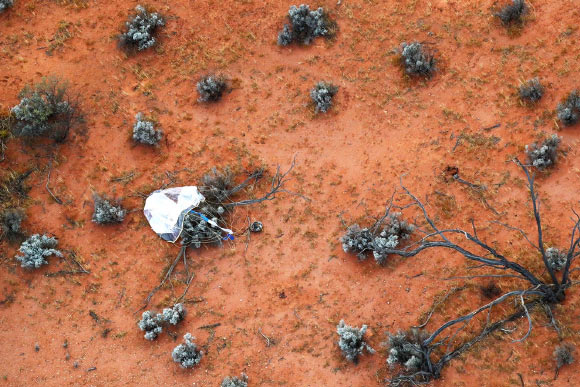On December 6, 2020, JAXA’s Hayabusa-2 spacecraft delivered a landing capsule with samples of material collected from the surface of the near-Earth asteroid (162173) Ryugu to the outback desert of Woomera in South Australia.

Hayabusa-2’s container with material from the near-Earth asteroid Ryugu and its parachute in South Australia. Image credit: JAXA.
Ryugu, also known as 1999 JU3, is a primitive carbonaceous asteroid that contains hydrated minerals and organic molecules. Its name refers to Ryūgū (Dragon Palace), a magical underwater palace in a Japanese folktale.
This asteroid was discovered in May 1999 by astronomers with the Lincoln Near-Earth Asteroid Research.
It measures approximately 900 m (0.56 miles) in diameter and orbits the Sun at a distance of 0.96-1.41 AU once every 474 days.
Hayabusa-2, a sample-return mission to Ryugu, was launched on December 3, 2014 and arrived at the asteroid on June 27, 2018.
There, the spacecraft deployed rovers and landers onto Ryugu’s surface, and collected samples from near the surface.

This illustration depicts JAXA’s Hayabusa-2 spacecraft at the asteroid Ryugu. Image credit: German Aerospace Center / CC-BY 3.0.
“We anticipate that the Hayabusa-2 samples of asteroid Ryugu will be very similar to the meteorite that fell in Australia near Murchison, Victoria, more than 50 years ago,” said Hayabusa-2 science team member Professor Trevor Ireland, a space rock expert in the Research School of Earth Sciences at the Australian National University.
“The Murchison meteorite opened a window on the origin of organics on Earth because these rocks were found to contain simple amino acids as well as abundant water.”
“We will examine whether Ryugu is a potential source of organic matter and water on Earth when the solar system was forming and whether these still remain intact on the asteroid,” he added.
“This C-type asteroid, which is the most common kind, appears to be similar to the Murchison meteorites — rare carbonaceous chondrites packed with organic molecules and water.”
“We might find that missing connection on Ryugu. We will also discover the history of this curious looking asteroid. The other rubble-pileasteroid Itokawa is quite young. Will Ryugu prove to be a lot older?”

This image of the asteroid Ryugu was captured by the Optical Navigation Camera – Telescopic (ONC-T) on JAXA’s Hayabusa-2 spacecraft on June 26, 2018, from a distance of 13.7 miles (22 km). Image credit: JAXA / University of Tokyo / Kochi University / Rikkyo University / Nagoya University / Chiba Institute of Technology / Meiji University / Aizu University / AIST.
“When I was in college in Japan in the 1990s, my college adviser told me about how the only samples we had were from the Apollo missions, plus meteorites that landed on Earth or cosmic dust found floating in the stratosphere,” said Dr. Keiko Nakamura-Messenger, a scientist and collection curator with NASA’s Astromaterials Research and Exploration Science Division.
“Now, I’m going to be one of the first people to touch this new astromaterial. It’s a great honor to see the sample before virtually anyone else can.”
“It’s exciting that this will be the first asteroid sample of its kind in-house,” said Dr. Christopher Snead, also from NASA’s Astromaterials Research and Exploration Science Division.
“To get ready, we’re finishing a new lab, as well as installing and configuring special equipment in order to work with samples that we expect will be made up of small particles and very, very tricky to handle.”
“Today marks an exciting and historic event as precious samples from asteroid Ryugu have been brought to Earth by JAXA’s Hayabusa-2 mission,” said Dr. Thomas Zurbuchen, associate administrator for NASA’s Science Mission Directorate.
“This is an extremely challenging endeavor and we commend and congratulate Japan on being not only the first nation that has been able to carry out a successful asteroid retrieval mission, but to now have done so for the second time!”
“We are excited about our collaboration between JAXA’s Hayabusa-2 mission and NASA’s asteroid sample return mission OSIRIS-REx, which extracted a sample from near-Earth asteroid Bennu on October 20.”
“Our mutually beneficial partnership with Japan allows us to share samples from NASA’s mission at Bennu and receive a portion of JAXA’s sample from Ryugu.”
“Together, we will gain a better understanding of the origins of our Solar System, and the source of water and organic molecules that could have seeded life on Earth.”







